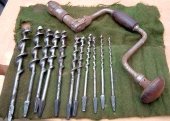
 28
28




A build too cool to miss:Mike's GreenhouseA great example:Joseph's Garden
All the soil info you'll ever need:
Redhawk's excellent soil-building series






 7
7




Some places need to be wild
 6
6




You are welcome to check out my blog at http://www.theartisthomestead.com or my artwork at http://www.davidhuang.org
 6
6




Gardens in my mind never need water
Castles in the air never have a wet basement
Well made buildings are fractal -- equally intelligent design at every level of detail.
Bright sparks remind others that they too can dance
What I am looking for is looking for me too!

 4
4




You are welcome to check out my blog at http://www.theartisthomestead.com or my artwork at http://www.davidhuang.org
 2
2









 6
6








Gardens in my mind never need water
Castles in the air never have a wet basement
Well made buildings are fractal -- equally intelligent design at every level of detail.
Bright sparks remind others that they too can dance
What I am looking for is looking for me too!





 1
1




Bradley Boyd. Many sailors have been maimed or killed when large nylon (read; elastic) anchor or tow lines parted (broke, snapped) under load. Dacron has far less stretch but still be aware. The best approach is to remain well clear of the load line under tension but this set up requires one to be right in the danger zone. [/quote wrote:
I totally agree. This was one of the matters I pondered over when I bought my first{and only} car. If I needed to tow another vehicle and the rope snapped, my rear windshield is gonna be a goner. In the absence of expert testimony I would consider tying a jacket or something similar at the quarter mark, half-way and at the 3-quarter mark. If the rope snaps, hopefully these airbrakes will absorb the energy.
For this winch, if you can rig a pulley halfway, you can pull on the load at 90 degrees. Again airbrakes halfway here and there.
A fishing nail knot should suffice to attach the airbrake. This is no time to tie an Alpine Butterfly since inline knots weaken the entire rope.
Alternative fanciful ideas revolve around tying a very loose thinner rope at intervals along the main rope. It too might snap but energy will be absorbed.
Last fanciful idea is to induce a weak spot by cutting one strand and tie anchors at either side of this spot.
I only tried this winch once and it works. I used the thickest rope I had on hand.
 4
4




Kathy Vargo wrote:I was thinking of getting a hydrolic winch, but this may due in a pinch. Can you do this with a metal cable like a winch? What would you adjust?
If it stinks, you're doing it wrong...
 9
9








 2
2





 1
1




Tradition is not the worship of ashes, but the preservation of fire.

|
Something about .... going for a swim. With this tiny ad ...
Rocket Mass Heater Resources Wiki
https://permies.com/w/rmh-resources
|



